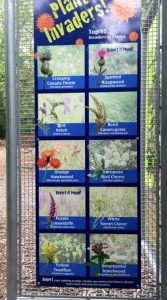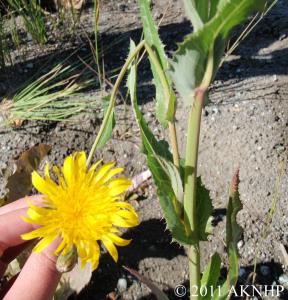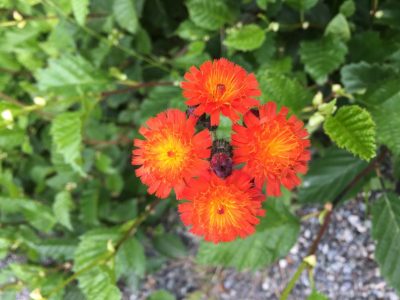 To Pull Or Not To Pull? Is It Native or Invasive
To Pull Or Not To Pull? Is It Native or Invasive
Invasive plants affect all areas of Alaska and need to be addressed by all Alaskans. Learning to identify invasive plants, animal and species can help reduce, if not eliminate, the negative effects such as complete elimination of native species. A great example is the chokecherry trees which are not native to Alaska. These can be found in yards, parks and along roadways demonstrating how aggressive the plant is. Three common species found in the Anchorage area are the Amur chokecherry, Canada red chokecherry and May Day tree. These can be dangerous to moose and streams.
According to the Department of Fish and Game there are several “pathways or vectors’ through which invasive species can be introduced. One pathway is “Human-Aided” which can be improved with education. Various routes included are: 1) contaminated cargo shipments arriving by air, land, or sea; 2) restoration, development or shipping projects that can inadvertently carry seeds, spores or larvae from one place to another; and 3) intentional or unintentional releases or introductions of aquatic species’.
In understanding invasive plants helpful definitions include:
Native: Plants that live or grow naturally in a particular region.
Non-native, exotic, alien, non-indigenous: Plants whose presence in a given area is due to the accidental or intentional introduction by humans.
Naturalized: Non-native plants that reproduce consistently in their new environment and sustain population over many life cycles without direct intervention by humans.
Invasive: Non-native plants that produce viable offspring in large numbers and have the potential to establish and spread in natural areas.
Weed: Any plants, native or non-native, whose presence is undesirable to people at a particular time or place.
Noxious weed: A plant species that has been legally defined a harmful and unwanted because of its potentially negative impacts to agriculture, fish and wildlife or public health.
The Alaska Natural Heritage Program through the University of Alaska Anchorage is available for public access providing information about “plant and animal and species of conservation or invasion concern”. This program was developed because of “limited resources available for managing invasive species that may be directed towards the most threatening species.” This site provides concepts of invasiveness and ranking, plant morphology and how to use this guide along with species description illustrations examples as seen below:
Perennial sow thistle â—Sonchus arvensis 
Invasiveness Rank: 73 points
Species Code: SOAR2
General Information:
Perennial: Woody stems 0.6-1.2 m tall
Description:
Roots: Extensive rhizomes
Stem: Glandular hairs on flower stalks and upper part of the stem
Leave: Clasping at the base, basal lobes ear-shaped and small
Inflorescence: Large (2.5-5 cm across)
On each floret, the ligule is approximately equal in length to its closed tubular section
Pappus mostly >1 cm long
Fruits: 4-5 ribbed Dark brown
Habitat: roadsides, disturbed sites, old home sites, coves and beaches
Distribution: Pacific maritime: scattered throughout
Interior boreal: northernmost records on the Dalton and Elliot Hwys near Livengood; also in vicinity of Delta
Remarks: There are two subspecies of Sonchus arvensis:
- arvensis ssp. arvensis has yellow, stalked, glandular hairs on stalks and stems below flower heads
- arvensis ssp. uliginosus has stalkless, glandular hairs
As noted above, species are ranked from zero to 100, with the Perennial sow thistle ranking at 73 points indicating it a more invasive species. Helpful tools to identify invasive plants include various guidebooks, 10x magnifying glass or handheld lens and 6′ flexible plastic ruler.
There are numerous guidebooks and resources available to assist in identifying invasive plants, animals and species. A few examples include:
 Selective Invasive Plants of Alaska, USDA United States Department of Agriculture, Forest Service Alaska Region R10-130B
Selective Invasive Plants of Alaska, USDA United States Department of Agriculture, Forest Service Alaska Region R10-130B
Alaska Invasive Species Workshop https://www.uaf.edu/ces/pests/cnipm/annual-invasive-species-c/
Alaska Weeds ID mobile application https://apps.bugwood.org/apps/alaska/
A few examples to watch for include these listed below from Invasive Plants of Alaska. Resources listed with each name:
Family: Asteraceae
Spotted Knapweed Centaurea biebersteinni (Resource 46)
Leaves and stems are covered in fine hairs without spiny leaves as found on thistles. Infestations have been reported along Turnagain Arm by UAF Coop Extension
Orange Hawkweed Hieracium aurantiacum (Resource 33)
Family: Brassicaceae
Found in the Upper Huffman area of Anchorage, AK
Garlic Mustard Alliaria petiolate (Resource 208)
Leaves are kidney-shaped the first year and heart-shaped the second with white flowers and a strong garlic odor. Juneau residents have been fighting to eradicate the plant with “infestations near the governor’s mansion. Traditionally the plant was used in soups and salads.
Family: Fabaceae
White Sweet Clover Melilotus alba (Resource 91, 92)
Leaves are trifoliate with white flowers. Burn areas provide excellent growing conditions.
Family: Poaceae
Kentucky Bluegrass Poa pratensis (Resource 64, 65)
Orchard grass Dactylis glomerata (Resource 60)
Foxtail Barley Hordeum jubatum (Resource 74)
Family: Polygnoaceae
Japanese Knotweed Polygnoum cuspidatum (Resource 178)
This species decreases the quality of habitat for wildlife and aquatic animals.
Other families include Apiaceae, Balsaminaceae, Euphorbiaceae, Haloragaceae, Lamiaceae, Lythraceae, and Scrophulariaceae
Reviewing the various families and utilizing the sources listed above to familiarize yourself with invasive species can help you recognize these when out hiking, camping, boating, picnicking, and berry picking. Any invasive species found should be reported to your nearest University of Alaska Cooperative Extension Services Office immediately.
Anchorage: https://www.uaf.edu/ces/districts/anchorage/contact/
Bethel: https://www.uaf.edu/ces/districts/bethel/
Delta Junction: https://www.uaf.edu/ces/districts/deltajunction/
Fairbanks: https://www.uaf.edu/ces/
Juneau: https://www.uaf.edu/ces/districts/juneau/
Nome: https://www.uaf.edu/ces/districts/nome/
Palmer: https://www.uaf.edu/ces/districts/matsu/
Sitka: https://www.uaf.edu/ces/districts/sitka/
Soldotna: https://www.uaf.edu/ces/districts/kenai/
TCC — Tanana Chief Conference: https://www.uaf.edu/ces/districts/tribes/
Resources
https://apps.bugwood.org/apps/alaska/
Photos: Plant Invaders taken by S. Hood at the Alaska Botanical Garden in Anchorage, AK 7/31/2016
Orange Hawkweed by S. Hood on Upper Huffman, Anchorage 6/26/2016
Perennial sow thistle taken by AKNHP and posted in the accs.uaa.alaska.edu Invasive Plants of Alaska
Selected Invasive Plants of AK is the cover to the Forest Service guidebook
I’m looking for information on Hemp Thistle. I bought some local hay and now have a problem……
I’m not finding anything about it.
Please submit your question
here..